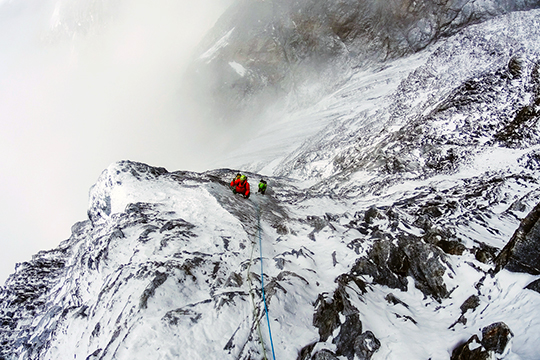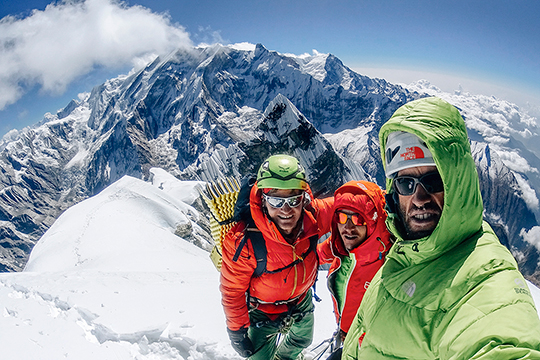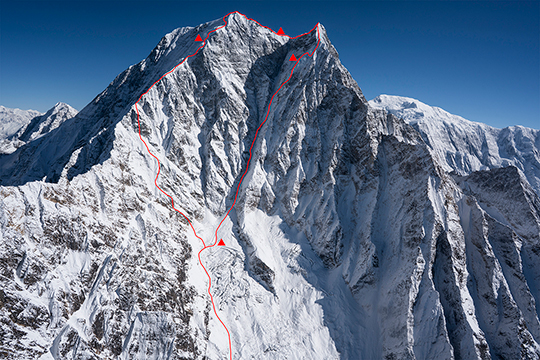
[Photo] Hansjorg Auer
“When we started the climb, we knew that we could not come down the same line because the gully was too dangerous to descend,” Hansjorg Auer told Alpinist in a recent interview. “We knew we would have to go down the southwest ridge. In the end, we had no other choice. I was sure for the last 200 meters up to the south summit that something was wrong.”
On October 5, Auer, Alexander “Alex” Blumel and Gerhard “Gerry” Fiegl traveled to Nepal from Austria with the goal of climbing Nilgiri South (6839m), the lowest of three peaks in the Nilgiri Himal in the Annapurna massif. In 1978, a Japanese team completed the first ascent of Nilgiri South by its East Ridge. The Austrian team intended to climb Nilgiri South’s unclimbed south face.
Following a steep, tricky approach, they established base camp at 4600 meters on the moraine that sprawls beneath Nilgiri South–instead of relying on the previous site used by Japanese, Czech, and Slovenian expeditions. This decision allowed them to acclimatize 350 meters higher than the other teams, but required a lot of labor to create platforms for their tents.

[Photo] Hansjorg Auer
According to Auer, acclimatizing on Nilgiri South proved difficult since there were few options for higher camps. Auer had an easier time adapting to the altitude than his teammates did, since he had just returned from Mt. Kenya (5199m) where he worked on a documentary with Reinhold Messner.
The team set up a bivy at 5200 meters, roughly 150 meters below the base of the climb, where they spent two nights continuing to acclimate. “We had only two nights at 5200 [meters], but we had no other options…we had to go for it,” Auer said. In the early morning of Oct. 23, they left the bivy and set off up a 600-meter gully filled with loose rock and steep ice in darkness to avoid dangerous daytime conditions. The team climbed unroped whenever possible for speed, only roping up on steep terrain.

[Photo] Hansjorg Auer
“The problem was it was really hard, blank ice. It was really dirty and melted out,” Auer said. In order to escape the gully, they opted to climb a spire to reach the summit ridge. They hoped the spire would provide a safer and more aesthetic alternative. They named the feature Nilgiri Spire.
After reaching the top of the spire at 6780 meters, roughly 60 meters lower than the true summit, Auer, Blumel, and Fiegl descended Nilgiri Spire’s north ridge and then downclimbed and rappelled steep and exposed terrain. They continued up to reach the summit of Nilgiri South at 11 a.m. on October 26.
“When we were on the spire, I recognized Gerhard was climbing a little bit slower, but at altitude your shape is often up and down,” Auer said.
From the top of the spire they were unable to descend the line they climbed. The only reasonable option was to continue to the summit, in spite of Fiegl’s deteriorating condition. “But then we saw for the first time that something was truly wrong,” Auer said. With high winds, they knew a helicopter rescue would be impossible. They paused on the summit for only two minutes and started down.
“After descending to 6500 meters, we could not go on, so we made another bivy and we tried to get him back. In the morning, he was better, but just for two hours and then his body was finished. He was falling on the part that was not steep–falling with no energy, not working against the fall,” Auer said. While descending unroped on easy slopes, Fiegl fell approximately 800 meters to his death.
After the accident, Auer and Blumel continued to descend for four more hours, reaching the glacier at 6 p.m. They left behind their entire rack of cams, ice screws, wires, pitons, and birdbeaks for anchors during the descent. “In the end, we finished with nothing. We used everything,” Auer said.
The Austrian route marks the second successful ascent of Nilgiri South. According to Auer, Nilgiri South had at least five previous attempts from the south by Slovenian, Japanese, and Czech teams, who attempted either the Southwest Ridge or the South Face.
Auer grieves for his friend Fiegl: “We grew up in the same village in Austria, a small village with 2,000 people. We started climbing together, but in the end I can’t say more than I’m sorry.”
Following their return to base camp, two helicopter flights attempted to recover Fiegl’s body. But they were unsuccessful. Auer said: “When we were coming back in the helicopter [on the second flight], I started to actually realize how amazing the line was that we climbed, that Gerry climbed. With all the blank ice and mixed climbing, we were really on the edge of our possibilities. Gerry stood on the summit of his biggest and most difficult climb and I’m thankful for that. I will never forget his shining eyes.”
